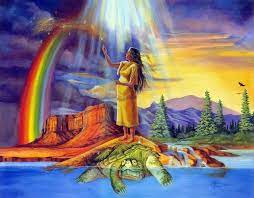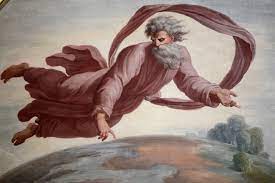The Haudenosaunee creation story is about Skywoman, a goddess, and her journey through the process of childbirth, in which she falls from the sky and is saved by animals of the earth. Particularly, a turtle, which thanks to Skywoman’s gratitude grew greater in size and land, and became an island, now known as Turtle Island. Skywoman is also considered to have given birth to the first humans (Watts, 2014, p. 247 as cited in Albanese, 2014). In the Haudenosaunee creation story, the obvious implication is that life: earth and human came from a woman, a goddess at that. The land is gendered as female, as are the origins of the first humans. The value placed on ‘woman’ as being the source of all creation demonstrates the high esteem, and respect women have within Haudenosaunee culture.
The sacred nature of Skywoman’s origins also creates an understanding that ‘women’, and their ability to birth children is a spiritual process. Particularly as the childbirth process is so strenuous and life-threatening, the Haudenosaunee consider childbirth as a gateway to the spirit world. Due to the centrality of the Skywoman story, and the matriarchal, and spiritual themes and ideology within it, the Haudenosaunee seem to hold women, and the qualities inherent to women in high esteem not only spiritually, but within their society and culture as well.

In contrast, the creation stories I was raised on were typically western ones. My father was raised Protestant in the Caribbean island of Grenada, and from the age of four, he would intermittently take me to Sunday school. There I learned of– the all-powerful, white, male, omniscient “God”, who created woman from man’s rib. Though my father taught me to question these values (and specifically ask the children’s pastors why women were blamed for much that went wrong in the bible), in a eurocentric and nation founded on Christian values, it is difficult to escape the ever-present and the ever-subjugated role women are given in Western creation stories.

Alternatively, my Korean mother was never one for religion, instead preferring to speak about ghosts and dreams. In this aspect I learned about how my gender was valued through my parent’s choice to give me both male-gendered names: Tumai, Swahili for hope, is short for Tumaini, normally a man’s name. Similarly, Gisung, a Korean name, normally masculine (and according to Google meaning “love of stars”, but according to my mom meaning “wise and success and accomplished”) was also chosen for its typically masculine attribution. When I asked my parents why both my names were traditionally boy’s names, they responded that women’s names placed precedence on attributes such as beauty and other feminine qualities. Instead, they wanted something strong. I question how difficult it could have been in the 1990s to find a name that was both feminine and strong.
In contrast to the Haudenosaunee appreciation for and woman’s reproductive and spiritual capabilities. My upbringing was reflective of the values of the Canadian settler-state. I grew up with immense pressure to graduate high school early, complete post-secondary ahead of time with minimal distractions, and begin a career as soon as possible (preferably in a STEM field). The rationale being that as a woman, I faced a biological and societal disadvantage in balancing both a career and a family. By graduating much ahead of my peers I would be able to have both.
Growing up, being a woman growing up always felt like an impediment, a disadvantage. Sometimes it still does. However, now, twenty-four and completing a joint degree in criminology, psychology and a minor in sociology, I understand how the eurocentric, capitalist, and patriarchal society has been structured to flourish through the submission of women. So, while I am ever more able to articulate my gendered experiences, I am equally able to reflect on the societal factors that gave way to my individual experiences, as well as consciously exercise my freedom of choice, in choosing my own life path.
I wonder what it may be like for Haudenosaunee women, who simultaneously have a rich history and culture of matriarchal values, that respect and value women’s roles and yet are enveloped in the patriarchal eurocentric and assimilationist Canadian settler-state.
References
| Albanese, P. (2014). Canadian families today: New perspectives (Third Edition) Oxford University Press. Deloche, P. (unknown) Hermitage Museum. The loggia of Raphael [stock image]. God creating Heaven and Earth https://www.gettyimages.ca/detail/photo/hermitage-museum-the-loggia-of-raphael-god-creating-royalty-free-image/538145428 Quenzer, Marcine. (2012). Skywoman [Illustration]. https://www.moma.org/collection/works/79802 |